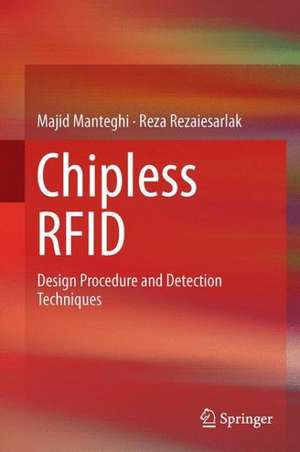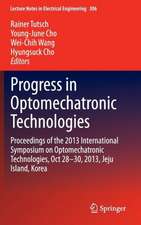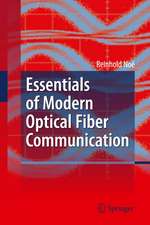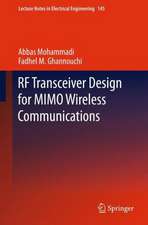Chipless RFID: Design Procedure and Detection Techniques
Autor Reza Rezaiesarlak, Majid Manteghien Limba Engleză Hardback – 18 dec 2014
| Toate formatele și edițiile | Preț | Express |
|---|---|---|
| Paperback (1) | 508.61 lei 38-44 zile | |
| Springer International Publishing – 10 sep 2016 | 508.61 lei 38-44 zile | |
| Hardback (1) | 640.24 lei 6-8 săpt. | |
| Springer International Publishing – 18 dec 2014 | 640.24 lei 6-8 săpt. |
Preț: 640.24 lei
Preț vechi: 753.22 lei
-15% Nou
Puncte Express: 960
Preț estimativ în valută:
122.55€ • 133.16$ • 103.01£
122.55€ • 133.16$ • 103.01£
Carte tipărită la comandă
Livrare economică 21 aprilie-05 mai
Preluare comenzi: 021 569.72.76
Specificații
ISBN-13: 9783319101682
ISBN-10: 3319101684
Pagini: 159
Ilustrații: VIII, 159 p. 148 illus., 80 illus. in color.
Dimensiuni: 155 x 235 x 15 mm
Greutate: 0.41 kg
Ediția:2015
Editura: Springer International Publishing
Colecția Springer
Locul publicării:Cham, Switzerland
ISBN-10: 3319101684
Pagini: 159
Ilustrații: VIII, 159 p. 148 illus., 80 illus. in color.
Dimensiuni: 155 x 235 x 15 mm
Greutate: 0.41 kg
Ediția:2015
Editura: Springer International Publishing
Colecția Springer
Locul publicării:Cham, Switzerland
Public țintă
ResearchCuprins
Radio Frequency Identification Systems.- Mathematical Representation of the Scattered Fields from Chipless RFID Tags.- Chipless RFID Tag.- Identification of Chipless RFID Tags in the Reader.- Detection, Identification and Localization in Chipless RFID Systems.
Notă biografică
Majid Manteghi, Associate professor at electrical and computer department of Virginia Tech.
Reza Rezaiesarlak PhD candidate at the department of electrical and computer Engineering, Virginia Tech.
Reza Rezaiesarlak PhD candidate at the department of electrical and computer Engineering, Virginia Tech.
Textul de pe ultima copertă
This book examines the design of chipless RFID systems. The authors begin with the historical development of wireless identification systems and finally arrive at a representation of the chipless RFID system as a block diagram illustration. Chapter 2 is devoted to the theoretical bases for the design of chipless RFID tags and detection techniques in the reader. A rigorous mathematical formulation is presented based on the singularity expansion method (SEM) and characteristic mode theory (CMT) in order to study the scattered fields from an object in a general form. Th e authors attempt to explain some physical concepts behind the mathematical descriptions of the theories in this chapter. In Chapter 3, two design procedures based on complex natural resonance and CMT are presented for the design of the chipless RFID tag. By studying the effects of structural parameters on radiation and resonant behaviors of the tag, some design conclusions are presented in this chapter. Chapter 4 is dedicated to the time-frequency analysis of the scattered fields from chipless RFID tags. After some explanation of the time-frequency analysis techniques and issues relating to resolution in time and frequency, an efficient technique called short-time matrix pencil method (STMPM) is introduced and efficiently employed to study various scattering mechanisms. Th e performance of the proposed technique against noise is studied in this chapter. Finally in Chapter 5, an anti-collision algorithm is presented through which the positions and IDs of multiple multi-bit tags are extracted from the backscattered signal of the tags present in the reader area.
Caracteristici
Provides simulation tools and measurement setups and presents numerical and experimental results to confirm the theoretical formulations Discusses MATLAB codes at the end of each chapter to allow the readers to simulate the results Presents theoretical issues for detection Includes supplementary material: sn.pub/extras




















